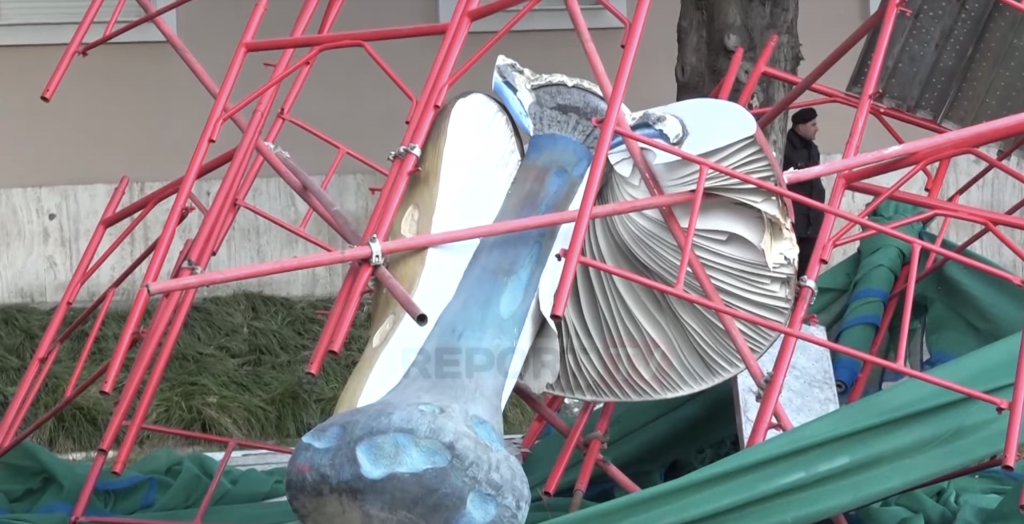
This article was originally published after protesters demolished the “Giant Triple Mushroom” in February 2019. Last week, Prime Minister Edi Rama replaced it with a new one over one meter higher.
In The Mushroom at the End of the World, Anna Lowenhaupt Tsing writes about using the “uncontrolled lives of mushrooms” as a “guide when the controlled world we thought we had fails.” The resilience of huge underground fungal networks contrasts with the fragility of our own human institutions.
I would like to consider another type of mushroom, a single (albeit not unique) one, which did not pop up his head after a surviving a manmade disaster, but rather one that has become somewhat of a symbol of the beginning of the end. I speak here, of course, of Carsten Höller’s “Giant Triple Mushroom.”
During the opposition protest on Saturday February 16, a few of the protestors took the opportunity to topple Höller’s multicolored mushroom, leading to a furious response of the Prime Minister, who publicly apologized to Höller. So how did we get there?
Höller’s “Giant Triple Mushroom” is a trace of the opening exhibition of the Center for Openness and Dialogue in 2015, when it was installed together with Philippe Parreno’s “Marquee Tirana,” which graces the facade of the Prime Ministry.
The exhibition, which further featured photographs by Thomas Demand, explicitly thematized the Albanian political climate. Höller’s mushroom was touted as the “first” work of the exhibition, evoking “various geographies, cultures, as well as degrees between edible and toxic,” which “can be perceived as a comment on Albanian politics.” The work could be interpreted as an ironic comment on another “mushroom” across the street, Ardian Isufi and Fatos Lubonja’s “Postbllok” monument for the victims of the communist dictatorship, which incorporates a “mushroom” bunker installed at the entrance of the Bllok neighborhood, where Prime Minister Edi Rama had the privilege of growing up during that same dictatorship as part of a nomenklatura family.
In a broader sense, the works of Höller and Parreno can be interpreted as works of propaganda for Edi Rama’s neoliberal (or, perhaps better, kleptocratic) “Third Way Socialism,” which continues to receive the staunch support of the likes of Tony Blair. Höller and Parreno both belong to the generation of Relational Aesthetics artists, who, in the words of artist Liam Gillick, are “skeptical shape-shifters in relation to the dominant culture” without ever taking up a clear political position. Naturally, their “meandering” is the only thing that has allowed them to support a disastrous regime such as Edi Rama’s.
So Parreno and Höller’s work are in a very traditional sense works of political propaganda, created by artists who support Rama’s regime. They are as much propaganda as the other artwork on the facade of the Prime Ministry, the basrelief by Edi Rama’s father, Kristaq Rama. And considering the literally flashy presence of the Parreno marquee, it is clear that Rama wants to outshine his own father’s heritage, while tragically repeating it.
Considering the symbolic baggage of these two works, it is not surprising that they have become the target of the opposition’s (physical) attacks. Even though one would doubt that many protestors are consciously aware of the art-historical context in which these works operate, the whole point of them being works of propaganda means that everyone unconsciously intuits they have symbolic, and thus political relevance.

The first occasion was only a few months after their installation, in December 2015, when Parreno’s “Marquee Tirana” was damaged after opposition protestors threw paint bombs at it.
As a result, when the opposition announced its first large demonstration in the 2016 National Elections season, Parreno’s work was protected with scaffolding, essentially blocking off the entrance of the Prime Ministry for the entire duration of the opposition’s “tent” protest, which lasted several months. Significantly, back then Höller’s “Giant Triple Mushroom” remained unprotected.
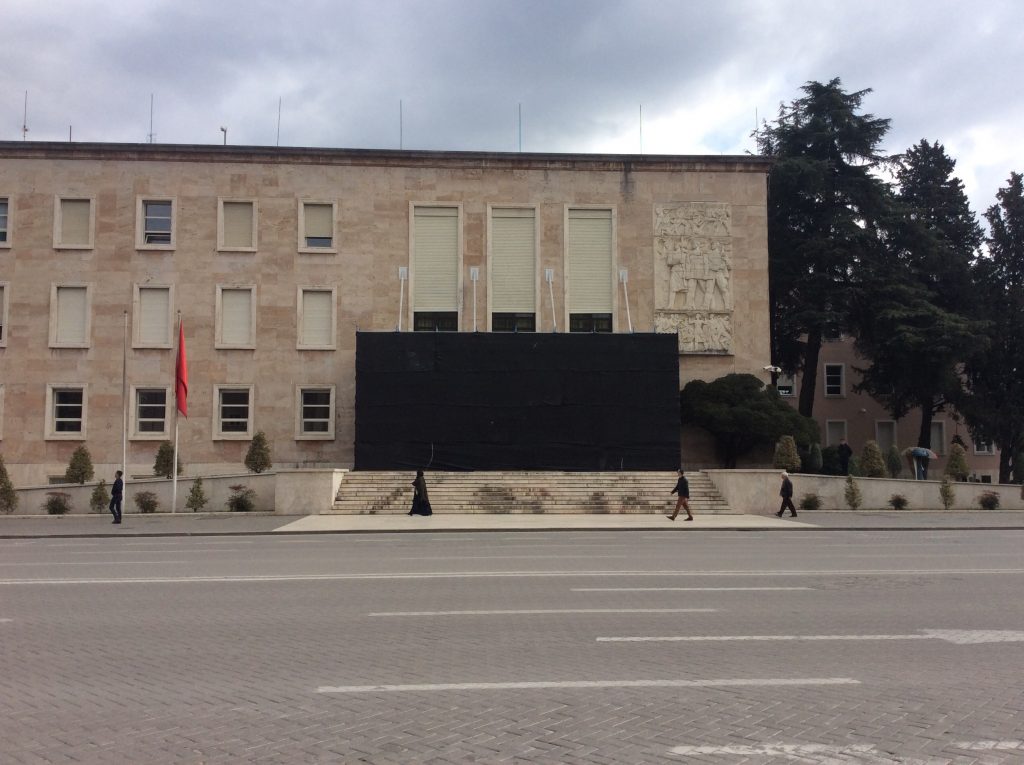
For the protests of February 16, however, both Parreno’s and Höller’s works were protected with scaffolding. It is unclear why this time Rama decided to protect both artworks (one wonders who performs those risk analyses), considering the fact that the mushroom is usually well protected behind the police lines surrounding the Prime Ministry during protests.
However, for reasons that are not entirely clear to me, the police forces at some point during the protest withdrew, after which the red metal scaffolding immediately turned from protecting the art works into becoming means of vandalizing them.
Protestors used the scaffolding to climb Parreno’s “Marquee Tirana” and attack the bulletproof doors of the Center for Openness and Dialogue, while the scaffolding around Höller’s “Giant Triple Mushroom” was leveraged to pull it asunder.
Whereas Prime Minister Edi Rama had been ignoring the protest the entire day, the toppling of his favorite mushroom clearly hit a nerve. At 16:41 he tweeted:
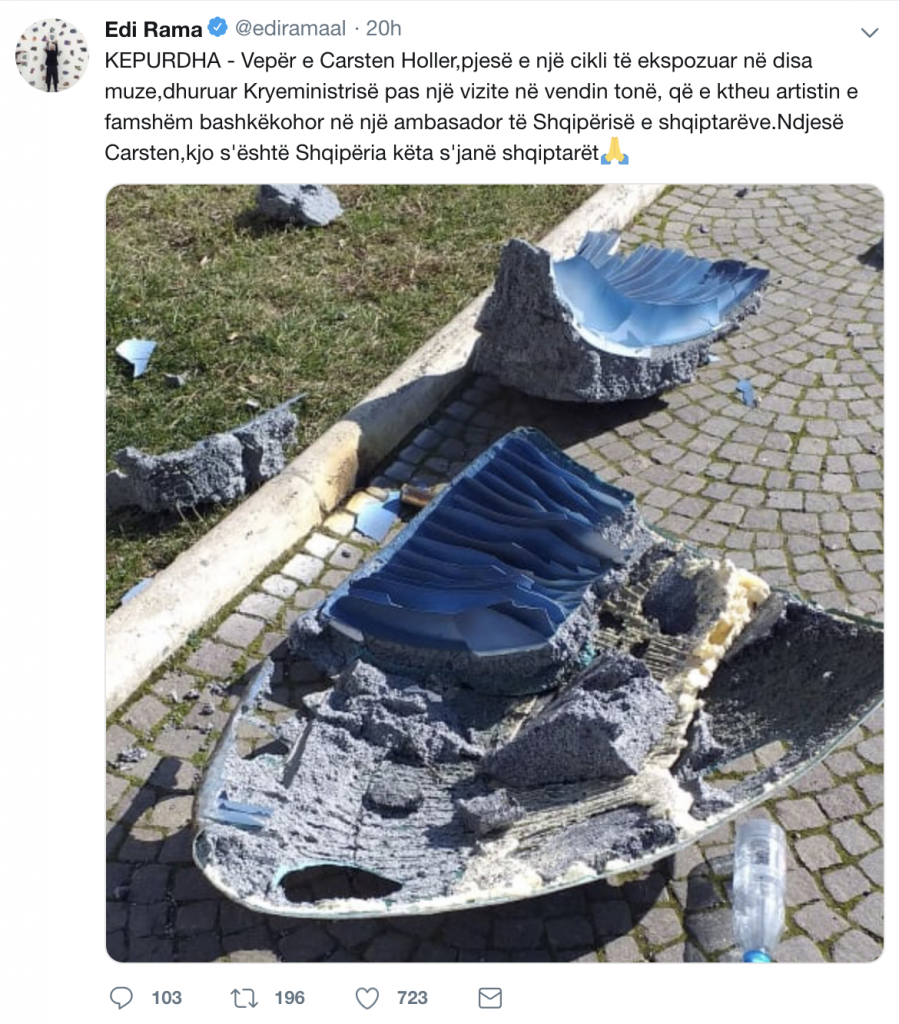
The work of Carsten Höller, part of a cycle [of works] exhibited in several museums, gifted to the Prime Ministry after a visit to our country, which turned the famous contemporary artist into an ambassador of Albania and the Albanians. I’m sorry Carsten, this isn’t Albanian and these aren’t Albanians.”
Note how this tweet, which are the first public words Rama ever spoke about Höller’s work, clearly stresses its political place of belonging (“gifted to the Prime Ministry”), contextualize it in a diplomatic context (“ambassador”), and moreover link its destruction to a certain anti-nationalism, implying that, indeed, he considers the “Giant Triple Mushroom” a national symbol.
Although an obvious parallel with the fall of Enver Hoxha’s statue in 1991 can be made, the toppling of “Giant Triple Mushroom” can perhaps best be compared with an iconoclastic act perpetrated by Rama himself, namely the destruction of the giant Albanian double-headed eagle at Sheshi Shqiponja, at the entrance of Tirana, placed there at the occasion of 100 years of Albanian independence celebrated in 2012.
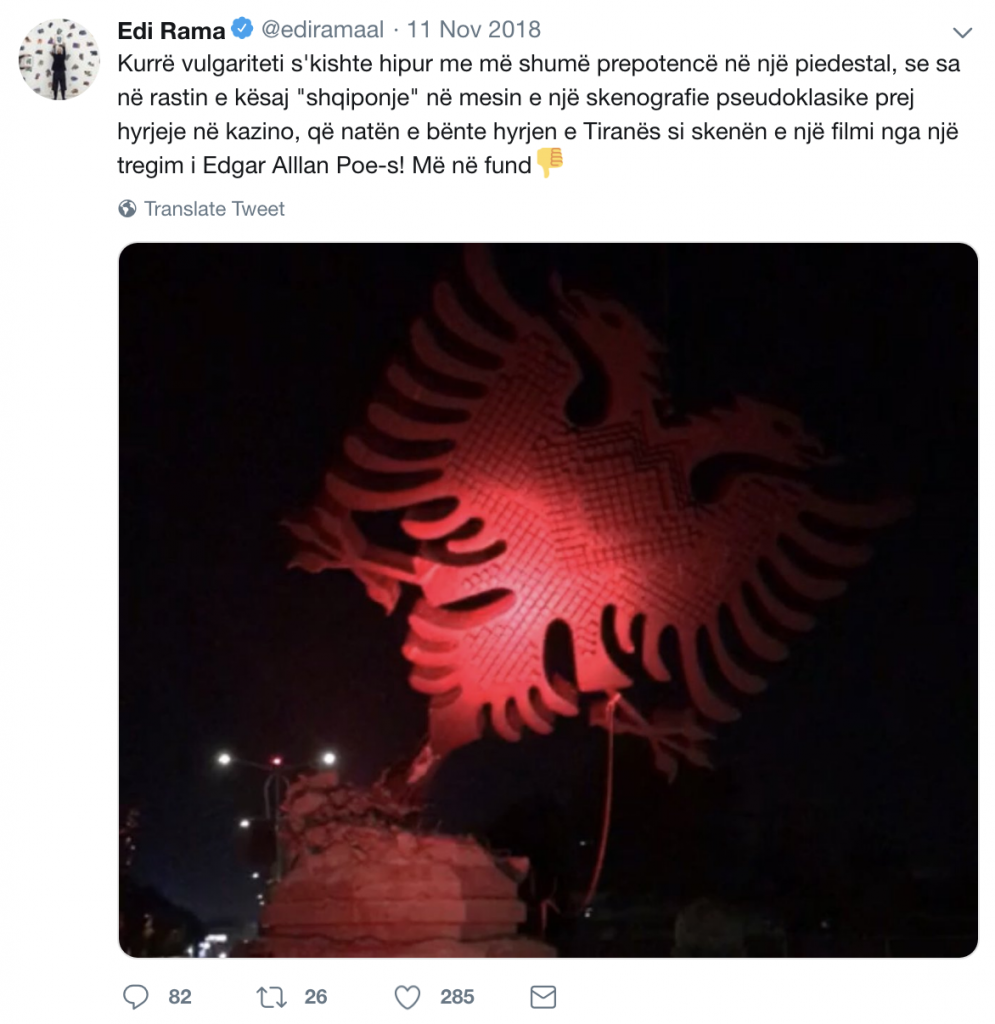
On November 11, 2018, only a few weeks before the celebration of Flag Day, which commemorates the foundation of the Albanian state, Rama tweeted an image of the red-lit, double-headed eagle being torn down.
“Never did vulgarity end up on a pedestal with more preposterousness than in the case of this “eagle” in the middle of pseudo-classical scenery from a casino entrance, which at night turned the entrance of Tirana into a film based on a story of Edgar Allen Poe! Finally.”
The most liked comment under this tweet referred directly to Parreno’s work:
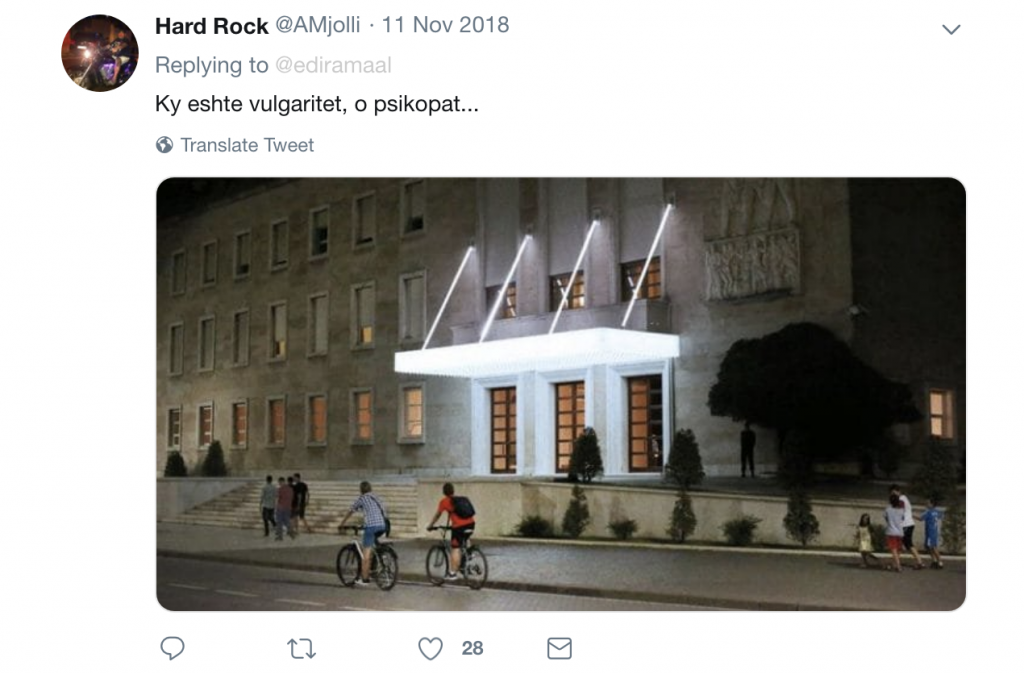
“This is vulgarity, oh psychopath…”
Throughout his term as Prime Minister, Edi Rama has consistently tried to recreate the visual symbolism that surrounds the Albanian state: from removing the portrait of the President from public offices, to thorough rebranding the logos and seals of government institutions. As such, he is not the first one. His predecessor Sali Berisha changed the colors of Albanian number plates from red–black to white–blue (used on EU number plates, and conveniently also the colors of the Democratic Party).
However, Rama has been more radical by appropriating a visual language – that of contemporary art – that on the surface appears incommensurable with the projection of state power. As such, he may have thought to have created a form of propaganda that is both understandable for the educated, “in-the-know” foreigner and unassailable for his own “cavemen” opponents.
The fate of “Giant Triple Mushroom” shows that this has been a miscalculation. One does need to understand the subtle curatorial gestures of Hans Ulrich Obrist in order to see that someone is being disingenuous. Because if you actually check the different mushrooms represented by Höller in his work (Amanita muscaria, Cortinarius traganus, and Clavariadelphus pistillaris), the first two are toxic, whereas the latter is simply bitter and inedible. It’s simply indigestible.
- Russian Demand For Foreign Passports Up Due To Travel Restrictions During Chinese Coronavirus
- Yes, Russia Could Work With US Against China

